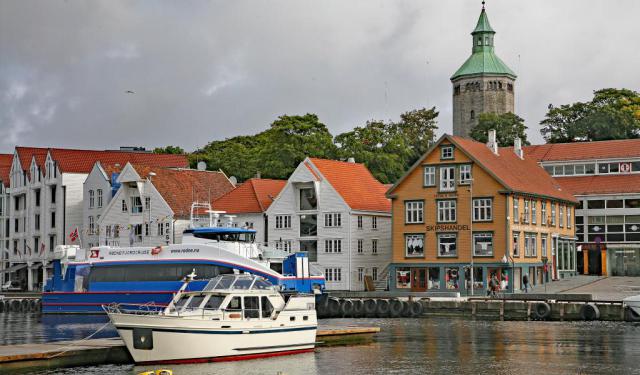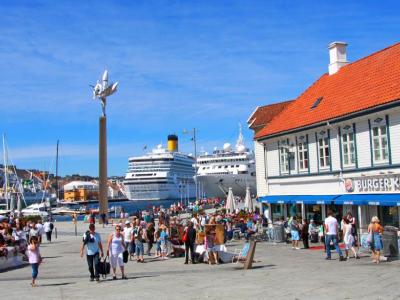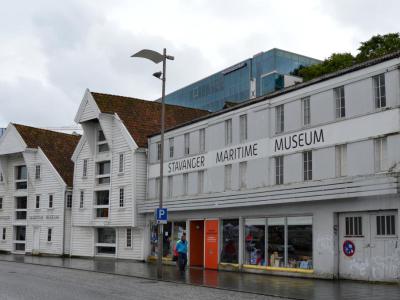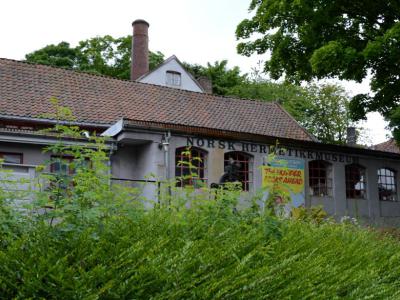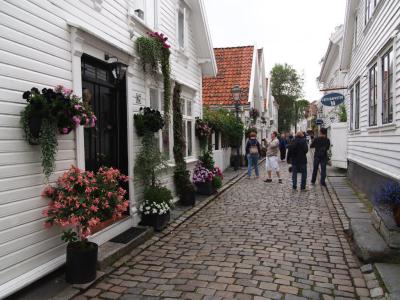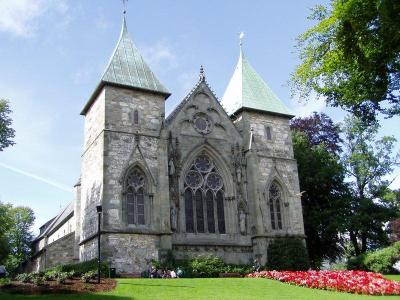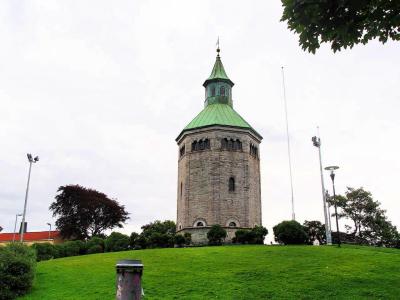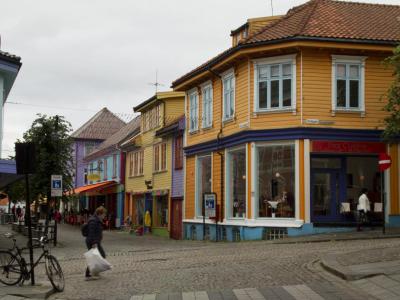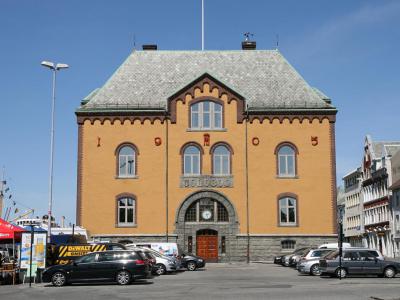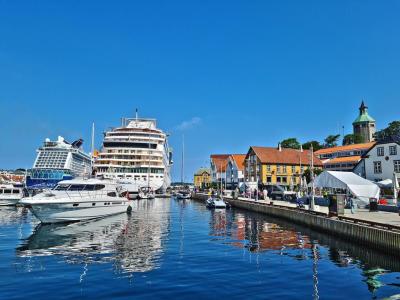Stavanger Introduction Walking Tour (Self Guided), Stavanger
Situated on the southwestern coast of Norway and only a five-hour drive south of the beautiful city of Bergen, bustling Stavanger is the country's third-largest city. It's also one of the oldest communities in Norway, tracing its roots as far back as the 12th century. Well sheltered by offshore islands, it's been a commercial center for centuries and is a popular cruise port today. ***PH***
How it works: Download the app "GPSmyCity: Walks in 1K+ Cities" from Apple App Store or Google Play Store to your mobile phone or tablet. The app turns your mobile device into a personal tour guide and its built-in GPS navigation functions guide you from one tour stop to next. The app works offline, so no data plan is needed when traveling abroad.
Stavanger Introduction Walking Tour Map
Guide Name: Stavanger Introduction Walking Tour
Guide Location: Norway » Stavanger (See other walking tours in Stavanger)
Guide Type: Self-guided Walking Tour (Sightseeing)
# of Attractions: 10
Tour Duration: 2 Hour(s)
Travel Distance: 2.5 Km or 1.6 Miles
Author: DanaOffice
Sight(s) Featured in This Guide:
Guide Location: Norway » Stavanger (See other walking tours in Stavanger)
Guide Type: Self-guided Walking Tour (Sightseeing)
# of Attractions: 10
Tour Duration: 2 Hour(s)
Travel Distance: 2.5 Km or 1.6 Miles
Author: DanaOffice
Sight(s) Featured in This Guide:
- Torget (Main Square)
- Stavanger Maritime Museum
- Norwegian Canning Museum
- Old Stavanger and Upper Strandgate Street
- Stavanger Domkirke (Stavanger Cathedral)
- Valbergtarnet (Valberg Tower)
- Norwegian Petroleum Museum
- Ovre Holmegate (Upper Holmegate Street)
- Toldboden (Customs Office)
- Skagenkaien Quay
1) Torget (Main Square)
Torget, also known as the Main Square, is a bustling and interesting square located near the harbor in Stavanger. It serves as a vibrant focal point in the heart of the city and offers a unique blend of art, commerce, and culture. Unlike traditional squares with defined shapes, Torget has a more open and wide layout. It slopes down from the Stavanger Cathedral to the waterfront, creating an interesting topography that adds character to the area.
Torget is known for its iconic shrimp sculpture perched atop a tall column. This striking sculpture is a prominent landmark in the square and adds a touch of whimsy to the surroundings.
The square has a lively marketplace atmosphere, especially during peak tourist seasons. Souvenir stalls are set up, and vendors engage in a bustling trade with visitors looking for mementos of their Stavanger experience. The square hosts an outdoor market where you can find a variety of typical tourist items. It's an excellent place to pick up gifts, local crafts, and keepsakes to remember your visit.
Torget is also a hub for tourists exploring Stavanger. Its central location and vibrant atmosphere make it a gathering point for travelers looking to explore the city's attractions, shop for souvenirs, or simply enjoy the ambiance. The square is surrounded by bars and cafes with outdoor seating, making it an ideal spot to relax, enjoy a meal or a drink, and people-watch.
Due to its prominent location, Torget is virtually impossible to miss. Whether you're arriving by boat at the harbor or exploring the city center on foot, you're likely to encounter this dynamic square.
Torget is known for its iconic shrimp sculpture perched atop a tall column. This striking sculpture is a prominent landmark in the square and adds a touch of whimsy to the surroundings.
The square has a lively marketplace atmosphere, especially during peak tourist seasons. Souvenir stalls are set up, and vendors engage in a bustling trade with visitors looking for mementos of their Stavanger experience. The square hosts an outdoor market where you can find a variety of typical tourist items. It's an excellent place to pick up gifts, local crafts, and keepsakes to remember your visit.
Torget is also a hub for tourists exploring Stavanger. Its central location and vibrant atmosphere make it a gathering point for travelers looking to explore the city's attractions, shop for souvenirs, or simply enjoy the ambiance. The square is surrounded by bars and cafes with outdoor seating, making it an ideal spot to relax, enjoy a meal or a drink, and people-watch.
Due to its prominent location, Torget is virtually impossible to miss. Whether you're arriving by boat at the harbor or exploring the city center on foot, you're likely to encounter this dynamic square.
2) Stavanger Maritime Museum
As you step into the Stavanger Maritime Museum, you'll find yourself immersed in a rich tapestry of exhibitions that vividly portray Stavanger's maritime legacy.
The museum's unique charm lies not only in its historical artifacts but also in its remarkable setting-the best-preserved merchants' buildings in Stavanger. These structures, steeped in tradition, serve as the ideal backdrop for a compelling exploration of the city's maritime heritage.
The heart of the Stavanger Maritime Museum beats within its captivating exhibitions, each offering a distinct window into the city's seafaring past:
Working at the Docks: Step into the shoes of late 1950s Stavanger at this interactive exhibition. A recreated quayside marketplace awaits children, where they can relive the bustling life of yesteryears.
The General Store: Transport yourself back to around 1910 as you enter this meticulously reconstructed shop. Adorned with decor and objects from various shops in the city, it's a time capsule of historic interior design.
Shipowner's Office: This authentic office interior once belonged to the Monsen family company, a stalwart in business from 1812 to 1977. It offers a glimpse into the world of maritime commerce.
The Merchant's Apartment: Step into a reconstructed apartment featuring a living room, dining room, home office, and kitchen with a pantry. The decor paints a vivid picture of what a merchant's residence might have looked like around 1910.
Sail Loft: Ascend to the very top of one of the warehouses and find yourself in a fully equipped sail loft. This exhibit provides a realistic insight into the working conditions of Stavanger's sail makers.
As you explore these exhibitions, you'll witness the meticulous attention to detail and historical accuracy that brings Stavanger's maritime history to life. From the bustling quayside market to the serene merchant's apartment, each exhibit offers a unique glimpse into the lives and livelihoods of the people who shaped Stavanger's maritime legacy.
The museum's unique charm lies not only in its historical artifacts but also in its remarkable setting-the best-preserved merchants' buildings in Stavanger. These structures, steeped in tradition, serve as the ideal backdrop for a compelling exploration of the city's maritime heritage.
The heart of the Stavanger Maritime Museum beats within its captivating exhibitions, each offering a distinct window into the city's seafaring past:
Working at the Docks: Step into the shoes of late 1950s Stavanger at this interactive exhibition. A recreated quayside marketplace awaits children, where they can relive the bustling life of yesteryears.
The General Store: Transport yourself back to around 1910 as you enter this meticulously reconstructed shop. Adorned with decor and objects from various shops in the city, it's a time capsule of historic interior design.
Shipowner's Office: This authentic office interior once belonged to the Monsen family company, a stalwart in business from 1812 to 1977. It offers a glimpse into the world of maritime commerce.
The Merchant's Apartment: Step into a reconstructed apartment featuring a living room, dining room, home office, and kitchen with a pantry. The decor paints a vivid picture of what a merchant's residence might have looked like around 1910.
Sail Loft: Ascend to the very top of one of the warehouses and find yourself in a fully equipped sail loft. This exhibit provides a realistic insight into the working conditions of Stavanger's sail makers.
As you explore these exhibitions, you'll witness the meticulous attention to detail and historical accuracy that brings Stavanger's maritime history to life. From the bustling quayside market to the serene merchant's apartment, each exhibit offers a unique glimpse into the lives and livelihoods of the people who shaped Stavanger's maritime legacy.
3) Norwegian Canning Museum
The Norwegian Canning Museum is a delightful surprise waiting to be uncovered. Housed within the walls of a venerable old cannery, this museum offers visitors a fascinating journey into a bygone era when sardines, not oil, ruled the economic landscape. Stavanger, once home to more than half of Norway's canning factories, pays homage to its flavorful past through this engaging museum.
Before oil wells dotted the Norwegian coast, it was the sardines that captured the hearts and livelihoods of Stavanger's inhabitants. At its zenith in 1922, the city's canneries were responsible for providing a staggering 50% of the town's employment. The Norwegian Canning Museum unearths this remarkable history, taking visitors through a captivating 12-stage process that transformed humble sardines into delectable canned delicacies.
The museum's exhibits meticulously guide visitors through each step of this intricate journey, from the art of salting to the meticulous threading, smoking, decapitating, and finally, the meticulous packing of these flavorful fish. The comprehensive narrative presented here offers a deeper appreciation for the painstaking work that went into transforming the ocean's bounty into a global culinary delight.
Adjacent to the museum's main building lies a perfectly restored workers' cottage. Step inside, and you're instantly transported back in time. Downstairs, you'll find yourself amidst the 1920s ambiance, while a climb upstairs reveals the style and decor of the 1960s. These meticulously curated settings provide a touching tribute to the lives of the men and women who toiled tirelessly in the canneries, highlighting the enduring spirit of community and resilience that defined the era.
Before oil wells dotted the Norwegian coast, it was the sardines that captured the hearts and livelihoods of Stavanger's inhabitants. At its zenith in 1922, the city's canneries were responsible for providing a staggering 50% of the town's employment. The Norwegian Canning Museum unearths this remarkable history, taking visitors through a captivating 12-stage process that transformed humble sardines into delectable canned delicacies.
The museum's exhibits meticulously guide visitors through each step of this intricate journey, from the art of salting to the meticulous threading, smoking, decapitating, and finally, the meticulous packing of these flavorful fish. The comprehensive narrative presented here offers a deeper appreciation for the painstaking work that went into transforming the ocean's bounty into a global culinary delight.
Adjacent to the museum's main building lies a perfectly restored workers' cottage. Step inside, and you're instantly transported back in time. Downstairs, you'll find yourself amidst the 1920s ambiance, while a climb upstairs reveals the style and decor of the 1960s. These meticulously curated settings provide a touching tribute to the lives of the men and women who toiled tirelessly in the canneries, highlighting the enduring spirit of community and resilience that defined the era.
4) Old Stavanger and Upper Strandgate Street (must see)
Upper Strandgate Street in the Old Stavanger offer a picturesque glimpse into the city's history and architecture. This charming historic area is featuring a collection of quaint, older homes nestled along winding, stone-paved streets. It is renowned as the largest surviving wooden house settlement in northern Europe and stands as one of the most beautiful and vibrant tourist destinations in Stavanger.
Gamle Stavanger is a significant historic district within the city, boasting numerous tranquil, wooden residences that date back to the 18th century. What makes this area particularly captivating is the uniform style and structure of these over 170 wooden houses.
These historic homes are constructed from timber and characterized by a unique architectural feature-an arch on the top of the roof that can be expanded to create additional living space. This design element, often referred to as the "Stavanger arch," lends the houses their distinctive appearance. The houses also feature flat tops, which are asymmetrically placed on the roof.
Upper Strandgate is a delightful street to explore on foot. Visitors can wander along the stone-paved streets, admire the charming houses, and soak in the ambiance of this historic neighborhood. The houses along Upper Strandgate Street all share similar design characteristics, creating a cohesive and visually appealing streetscape. The area offers a peaceful and picturesque setting for a leisurely stroll.
Gamle Stavanger is a significant historic district within the city, boasting numerous tranquil, wooden residences that date back to the 18th century. What makes this area particularly captivating is the uniform style and structure of these over 170 wooden houses.
These historic homes are constructed from timber and characterized by a unique architectural feature-an arch on the top of the roof that can be expanded to create additional living space. This design element, often referred to as the "Stavanger arch," lends the houses their distinctive appearance. The houses also feature flat tops, which are asymmetrically placed on the roof.
Upper Strandgate is a delightful street to explore on foot. Visitors can wander along the stone-paved streets, admire the charming houses, and soak in the ambiance of this historic neighborhood. The houses along Upper Strandgate Street all share similar design characteristics, creating a cohesive and visually appealing streetscape. The area offers a peaceful and picturesque setting for a leisurely stroll.
5) Stavanger Domkirke (Stavanger Cathedral) (must see)
Stavanger Cathedral is a testament to the enduring power of faith and architectural splendor. This venerable stone edifice, shrouded in gray, was built around 1125, making it Norway's oldest cathedral. It is here that the Bishop of Stavanger leads the Diocese of Stavanger within the Church of Norway. The architect behind this masterpiece remains anonymous, yet their vision has stood the test of time.
The cathedral is a stunning example of Romanesque design, characterized by its three aisles with diaphragm arches and an elevated central nave. As you gaze upon the central nave, you'll be captivated by an arcade adorned with round pillars, each telling a story through intricate carvings. The capitals atop these pillars offer glimpses into scenes from Ragnarok (End of Days), a captivating touch that speaks to the depth of Norse mythology and history.
As you explore the cathedral's exterior, you'll discover two majestic towers graced with lancet windows. The space between these towers and the central structure is adorned with sculptures, each revealing a piece of the cathedral's rich history and spiritual significance.
Around 1660, the gallery's parapet received a delicate artistic touch, with motifs inspired by the Cor Iesu Amanti Sacrum series, known as "Emblems from the Heart." Three of these original motifs are now on display in Stavanger Museum, a testament to the cathedral's enduring cultural and historical value.
Editor's Note: Stavanger Cathedral is temporarily closed for renovations.
The cathedral is a stunning example of Romanesque design, characterized by its three aisles with diaphragm arches and an elevated central nave. As you gaze upon the central nave, you'll be captivated by an arcade adorned with round pillars, each telling a story through intricate carvings. The capitals atop these pillars offer glimpses into scenes from Ragnarok (End of Days), a captivating touch that speaks to the depth of Norse mythology and history.
As you explore the cathedral's exterior, you'll discover two majestic towers graced with lancet windows. The space between these towers and the central structure is adorned with sculptures, each revealing a piece of the cathedral's rich history and spiritual significance.
Around 1660, the gallery's parapet received a delicate artistic touch, with motifs inspired by the Cor Iesu Amanti Sacrum series, known as "Emblems from the Heart." Three of these original motifs are now on display in Stavanger Museum, a testament to the cathedral's enduring cultural and historical value.
Editor's Note: Stavanger Cathedral is temporarily closed for renovations.
6) Valbergtarnet (Valberg Tower)
Standing tall as a silent sentinel over Stavanger's historic landscape, the Valberg Tower, is a testament to the city's rich history and its unwavering commitment to safeguarding its citizens. Constructed between 1850 and 1853 by the renowned architect Chr. Grosch, this tower served as a watchmen's tower, an iconic structure that played a vital role in the city's past.
The Valbergtårnet Tower was not just a lofty structure; it was the vigilant guardian of Stavanger. Watchmen, who called this tower home, kept a tireless watch over the city's well-being. Among their many duties, perhaps the most critical was their responsibility to sound the alarm in case of fire. As flames danced and threatened, the watchmen's cries would echo through the streets, rallying the community to action.
One of the tower's most celebrated watchmen was Tobias Sandstøl, a guardian of Stavanger for an impressive 18 years until 1922. His dedicated service left an indelible mark on the city and even found a place in the pages of literature. The beloved children's book author, Torbjørn Egner, drew inspiration from real-life heroes like Tobias when crafting his timeless tale of Kardemommeby, the town of cardamom. In the world of fiction, "Tobias in the tower" becomes a cherished character, forever linked to the Valberg Tower's storied history.
Today, Valbergtårnet Tower stands not only as a historical monument but as a living museum, offering a glimpse into the lives and duties of the watchmen who once called it home. The tower's first floor houses a watchmen's museum, a treasure trove of artifacts and stories that captivate history enthusiasts and curious school classes alike. Visitors can step back in time, retracing the steps of these dedicated guardians of Stavanger.
The Valbergtårnet Tower was not just a lofty structure; it was the vigilant guardian of Stavanger. Watchmen, who called this tower home, kept a tireless watch over the city's well-being. Among their many duties, perhaps the most critical was their responsibility to sound the alarm in case of fire. As flames danced and threatened, the watchmen's cries would echo through the streets, rallying the community to action.
One of the tower's most celebrated watchmen was Tobias Sandstøl, a guardian of Stavanger for an impressive 18 years until 1922. His dedicated service left an indelible mark on the city and even found a place in the pages of literature. The beloved children's book author, Torbjørn Egner, drew inspiration from real-life heroes like Tobias when crafting his timeless tale of Kardemommeby, the town of cardamom. In the world of fiction, "Tobias in the tower" becomes a cherished character, forever linked to the Valberg Tower's storied history.
Today, Valbergtårnet Tower stands not only as a historical monument but as a living museum, offering a glimpse into the lives and duties of the watchmen who once called it home. The tower's first floor houses a watchmen's museum, a treasure trove of artifacts and stories that captivate history enthusiasts and curious school classes alike. Visitors can step back in time, retracing the steps of these dedicated guardians of Stavanger.
7) Norwegian Petroleum Museum (must see)
Nestled along the picturesque Port of Stavanger the Norwegian Petroleum Museum stands as an architectural marvel that echoes the region's deep-rooted connection with the offshore petroleum industry. Designed by the esteemed architectural firm Lunde & Løvseth Arkitekter A/S, this museum, opened on 20 May 1999, transcends mere bricks and mortar. Its distinctive design, reminiscent of an oil platform when viewed from the sea, is a testament to human ingenuity and innovation in the realm of oil and gas exploration.
Crafted from stone, glass, and concrete, this edifice is not merely a building but an immersive experience. Its materials, meticulously chosen, reflect the strength, resilience, and transparency that have come to define Norway's petroleum industry.
As you step inside the Norwegian Petroleum Museum, you embark on a journey through time and technology. The museum's raison d'être is the offshore petroleum activity, primarily in the North Sea, and it narrates this compelling tale with precision. On display are a myriad of objects, films, photographs, and other artifacts that meticulously document Norway's oil and gas endeavors.
The museum serves as a visual and informational feast, tracing the technological evolution of Norway's oil industry. From the embryonic days of North Sea drilling platforms in the mid-1960s to the robust steel and concrete structures engineered and constructed on Norwegian soil, and onward to the contemporary, flexible production ships and subsea systems-the Norwegian Petroleum Museum maps this transformative odyssey.
Crafted from stone, glass, and concrete, this edifice is not merely a building but an immersive experience. Its materials, meticulously chosen, reflect the strength, resilience, and transparency that have come to define Norway's petroleum industry.
As you step inside the Norwegian Petroleum Museum, you embark on a journey through time and technology. The museum's raison d'être is the offshore petroleum activity, primarily in the North Sea, and it narrates this compelling tale with precision. On display are a myriad of objects, films, photographs, and other artifacts that meticulously document Norway's oil and gas endeavors.
The museum serves as a visual and informational feast, tracing the technological evolution of Norway's oil industry. From the embryonic days of North Sea drilling platforms in the mid-1960s to the robust steel and concrete structures engineered and constructed on Norwegian soil, and onward to the contemporary, flexible production ships and subsea systems-the Norwegian Petroleum Museum maps this transformative odyssey.
8) Ovre Holmegate (Upper Holmegate Street) (must see)
Nestled amidst the pristine white buildings that grace central Stavanger there's a street that's anything but ordinary. Upper Holmegate, affectionately known as the Colour Street, is a vibrant and lively commercial hub that has become a beloved local gem and a must-visit destination for tourists.
Once upon a time, Upper Holmegate was just another street in Stavanger's historic shopping district. It had its own charm, but nothing that set it apart from the rest. However, in 2005, a local hairdresser named Tom Kjørsvik envisioned something different. He yearned to create an inviting and lively atmosphere to entice more visitors to his salon and the neighboring businesses. With a stroke of creative genius, he embarked on a mission to infuse the street with color, forever changing its destiny.
Tom Kjørsvik's vision for Upper Holmegate was inspired by the vibrant color palettes of Miami Vice, and he wasn't alone in his dream. The Scottish artist Craig Flannagan joined forces with Kjørsvik, and together, they embarked on an artistic journey that would redefine the street. The dull façades of the houses on either side of Upper Holmegate became the canvas for this transformation.
What sets Upper Holmegate apart is not just its kaleidoscope of colors but the thoughtful combinations that adorn each building. Each house was carefully assigned a unique set of colors for its façade, doors, and window frames. These combinations were meticulously chosen to create a harmonious symphony of hues that playfully dance from one building to the next. The result is a breathtaking visual experience that seamlessly weaves together a vibrant tapestry.
Today, Upper Holmegate is a bustling hub where locals and tourists alike come to soak in the cheerful ambiance. The street is not just a tourist attraction; it's a thriving community where you'll find cafes and bars filled with patrons enjoying everything from a quiet lunch to late-night revelry.
Once upon a time, Upper Holmegate was just another street in Stavanger's historic shopping district. It had its own charm, but nothing that set it apart from the rest. However, in 2005, a local hairdresser named Tom Kjørsvik envisioned something different. He yearned to create an inviting and lively atmosphere to entice more visitors to his salon and the neighboring businesses. With a stroke of creative genius, he embarked on a mission to infuse the street with color, forever changing its destiny.
Tom Kjørsvik's vision for Upper Holmegate was inspired by the vibrant color palettes of Miami Vice, and he wasn't alone in his dream. The Scottish artist Craig Flannagan joined forces with Kjørsvik, and together, they embarked on an artistic journey that would redefine the street. The dull façades of the houses on either side of Upper Holmegate became the canvas for this transformation.
What sets Upper Holmegate apart is not just its kaleidoscope of colors but the thoughtful combinations that adorn each building. Each house was carefully assigned a unique set of colors for its façade, doors, and window frames. These combinations were meticulously chosen to create a harmonious symphony of hues that playfully dance from one building to the next. The result is a breathtaking visual experience that seamlessly weaves together a vibrant tapestry.
Today, Upper Holmegate is a bustling hub where locals and tourists alike come to soak in the cheerful ambiance. The street is not just a tourist attraction; it's a thriving community where you'll find cafes and bars filled with patrons enjoying everything from a quiet lunch to late-night revelry.
9) Toldboden (Customs Office)
The Customs Office, is an architectural gem that welcomes all who arrive by boat or ship to this coastal Norwegian city. Designed in 1905 by the renowned architect Schak August Bull, this imposing structure stands as a testament to the city's maritime heritage and its enduring role as a hub of international trade.
At the dawn of the 20th century, Skagenkaien in Stavanger's harbor bustled with maritime activity. Ships laden with cargo and goods from around the globe frequented this bustling waterfront. It was against this dynamic backdrop that the Toldboden was conceived-a grand testament to the city's thriving trade.
Designed in the Jugend style, characterized by its flowing lines and artistic embellishments, the Toldboden seamlessly marries this contemporary aesthetic with medieval elements. The building's ground floor, fashioned from rugged grey stone, exudes an aura of solidity and resilience-a nod to the maritime industry's robust nature. Rising above the stone base, the upper levels of the building are bathed in a warm yellow ochre hue, creating a harmonious contrast.
The grand roof, adorned with grey sheet stone, is a hallmark of the era and showcases the architect's mastery of design. Terracotta detailing in a rich maroon hue embellishes the windows, cornerstones, and roof, underscoring the structure's historical significance. Above the main entrance, in bold gothic letters, the word "Toldbod" proudly announces the building's purpose as a customs office. The year of completion and the crest of King Haakon VII, Norway's monarch at the time, further adorn the facade.
While it once bustled with customs officials and trade, today, Toldboden has transitioned into a multifunctional venue. It plays host to a myriad of events, from concerts to dining experiences, welcoming both locals and visitors to its hallowed halls. The square and surrounding area have become a beloved space for relaxation and gatherings
At the dawn of the 20th century, Skagenkaien in Stavanger's harbor bustled with maritime activity. Ships laden with cargo and goods from around the globe frequented this bustling waterfront. It was against this dynamic backdrop that the Toldboden was conceived-a grand testament to the city's thriving trade.
Designed in the Jugend style, characterized by its flowing lines and artistic embellishments, the Toldboden seamlessly marries this contemporary aesthetic with medieval elements. The building's ground floor, fashioned from rugged grey stone, exudes an aura of solidity and resilience-a nod to the maritime industry's robust nature. Rising above the stone base, the upper levels of the building are bathed in a warm yellow ochre hue, creating a harmonious contrast.
The grand roof, adorned with grey sheet stone, is a hallmark of the era and showcases the architect's mastery of design. Terracotta detailing in a rich maroon hue embellishes the windows, cornerstones, and roof, underscoring the structure's historical significance. Above the main entrance, in bold gothic letters, the word "Toldbod" proudly announces the building's purpose as a customs office. The year of completion and the crest of King Haakon VII, Norway's monarch at the time, further adorn the facade.
While it once bustled with customs officials and trade, today, Toldboden has transitioned into a multifunctional venue. It plays host to a myriad of events, from concerts to dining experiences, welcoming both locals and visitors to its hallowed halls. The square and surrounding area have become a beloved space for relaxation and gatherings
10) Skagenkaien Quay
The Skagenkaien Quay-a captivating waterfront destination that effortlessly blends maritime heritage with contemporary charm. Nestled within a stone's throw of the renowned Stavanger Maritime Museum and The Norwegian Petroleum Museum, Skagenkaien beckons travelers with its vibrant quayside bars, historic allure, and bustling atmosphere. Here, against a backdrop of sailboats, cruise ships, and the ebb and flow of life in Stavanger, you'll discover a place to savor, stroll, and soak in the city's spirit.
Skagenkaien Quay stands as an integral part of Stavanger's storied waterfront, steeped in history and brimming with character. As you wander through this charming area, you'll be greeted by cobblestone streets, statues, and sculptures that whisper tales of days gone by. The quay's romantic wooden buildings, reminiscent of Norway's architectural heritage, create a captivating ambiance that transports you through time.
One cannot help but be enchanted by the lively bars that line Skagenkaien, offering not just a taste of local beverages but also stunning vistas of the harbor and cruise port. Whether you're sipping a cold drink, enjoying a meal at a waterfront restaurant, or simply people-watching, Skagenkaien provides the perfect setting.
Skagenkaien is a mecca for food enthusiasts, offering a plethora of dining options to satisfy your cravings. From seafood delights to international cuisine, the area's restaurants cater to every palate. And as you dine, you can revel in the maritime symphony playing out before you.
The quay is dotted with souvenir shops, beckoning you to find that perfect memento of your visit to this picturesque city. As the day turns into evening, Skagenkaien comes alive with the buzz of locals and tourists alike, creating a vibrant, welcoming atmosphere.
Skagenkaien Quay stands as an integral part of Stavanger's storied waterfront, steeped in history and brimming with character. As you wander through this charming area, you'll be greeted by cobblestone streets, statues, and sculptures that whisper tales of days gone by. The quay's romantic wooden buildings, reminiscent of Norway's architectural heritage, create a captivating ambiance that transports you through time.
One cannot help but be enchanted by the lively bars that line Skagenkaien, offering not just a taste of local beverages but also stunning vistas of the harbor and cruise port. Whether you're sipping a cold drink, enjoying a meal at a waterfront restaurant, or simply people-watching, Skagenkaien provides the perfect setting.
Skagenkaien is a mecca for food enthusiasts, offering a plethora of dining options to satisfy your cravings. From seafood delights to international cuisine, the area's restaurants cater to every palate. And as you dine, you can revel in the maritime symphony playing out before you.
The quay is dotted with souvenir shops, beckoning you to find that perfect memento of your visit to this picturesque city. As the day turns into evening, Skagenkaien comes alive with the buzz of locals and tourists alike, creating a vibrant, welcoming atmosphere.
The Most Popular Cities
/ view all
